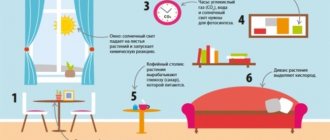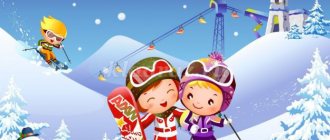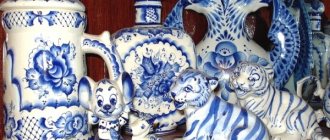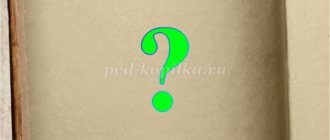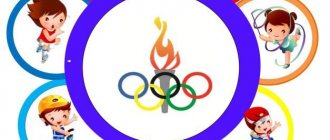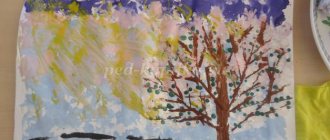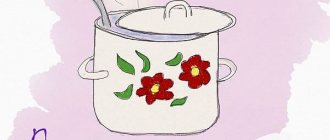Preparatory group. Senior preschool age. Children 6-7 years old
Summary of a lesson on cognitive development with elements of TRIZ technology in the preparatory group “Wildlife” Topic: “Wildlife”
.
Objectives: Show children that a tree is alive, it consists of solid, liquid and gaseous people. Equipment: Diagrams of solid, liquid and gaseous people. Organizational moment: The teacher asks the children to approach the birch tree. Progress of the lesson : (at the site...
Summary of the lesson using TRIZ technology “Seven Planks of Mastery” for children with STD (preparatory group)
Author's full name: Ruban Lyudmila Arkadyevna Title of work: Methodological development using TRIZ
technology " Seven Planks of Mastery"
Purpose : to promote intellectual development...
Summary of a lesson on speech development using TRIZ in the preparatory group of a kindergarten
Summary of GCD on speech development using TRIZ in the preparatory group on the topic “Fairytale Land”
This lesson will be interesting and useful for conducting in the senior and preparatory groups of kindergarten. The lesson is conducted in a fun and playful way. As an idea, it can be used in entertainment on the theme “Fairy Tales” Program content. 1. Tasks for the development of cognitive abilities: consolidate material on the topic “Russian folk tales”, “Tales of foreign writers”, “Literary tales”; develop imagination in accordance with the task, using nearby resources; learn how to solve simple problems. 2. Speech development tasks: develop children’s coherent speech; consolidate skills in using verbal vocabulary in speech, agreement of adjectives and nouns; mastering antonym words. 3. Educational objectives: to develop the emotional sphere of children: the ability to empathize with the heroes of works, to understand the concepts of “Good - Evil”, “Strong - Weak”; cultivate determination and perseverance in finding solutions to emerging problems. Material for the lesson. Picture-scheme “Fairytale Country” with schematic houses, trees, river. Cards:
“positive heroes of fairy tales”, “negative heroes of fairy tales”.
Preliminary work. Reading stories and fairy tales on the topic. Inventing a fantasy state in which heroes of various fairy tales live. Drawing a “geographical map” of this state with the children. Follow-up work. Game "Wonderful Things". Invention of the “House of Friendship” (drawing, modeling, design). Coming up with an ending to the fairy tale (how our heroes will live in the “House of Friendship”, what adventures will happen to them later). Organization. Children sit in a semicircle.
In front of them on an easel is a map-scheme of the “Fairytale Land”. Course of the lesson
: Relaxation. Close your eyes, listen to the voices of summer. (The audio recording “Sounds of the Summer Garden” is turned on.) Educator. Summer has come. The sun in the sky is clear, warm, radiant, it shines for everyone and makes everyone happy. There is lush greenery on the trees. Fruits are ripening in the gardens, bright flowers are blooming in the flower beds. Beautiful butterflies fly over the flowers, and hardworking bees buzz. Carefree grasshoppers hop along the grass and hard-working ants scurry here and there. Animals frolic in the forest. The birds happily sing their summer songs. The children rejoice and stretch out their palms upward, and the sun warms them, warms them with its rays. Good, warm, calm. Let's say hello to the Sun, a gentle Summer! Children . Hello Sunshine! Hello summer! Educator . Summer is a fun and fabulous time of year! Do you like fairy tales? You and I know a lot of fairy tales, but today I want to come up with my own fairy tale - good, new, interesting, magical. Let's come up with such a fairy tale together! Do you agree? Far, far away among the forests and mountains, a new state has appeared - “Fairytale Land”. The country was divided in half by the Skazochka River. To the right of the river lived the negative heroes of fairy tales. What negative heroes do you know? (Children's answers). What can they do? (we attach pictures of the houses of the named fairy tale characters to the card with magnets). Didactic game “Who does what” Educator. Karabas - Barabas? Children . Looking for the key, getting angry, torturing the dolls... Educator. Barmaley? Children . Runs around Africa, scares everyone... Educator . Fairytale Fox? Children . Sneaks, offends the weak, is cunning... Educator . Baba Yaga? Children . Scares, flies on a mortar, stokes the stove... Educator . Wolf? Children . Hunts, howls, gets angry... Educator . Koschei the Deathless? Children . He steals princesses, hoards gold, scares people... Educator . Signor - Tomato? Children . He gets angry and doesn’t let other vegetables live... Educator . One hero doesn't have a house. Who? Children . At Barmaley's. Educator . What are the names of other fairy-tale characters' houses? The didactic game “Where do fairy-tale heroes live?” The teacher lists the characters, and the children name their home (Karabas - barabas: puppet theater, Baba - Yaga: hut on chicken legs, etc.) Educator . Let's continue the tale. To the left of the river lived the positive heroes of various fairy tales. Who do you think it is? Children . Pinocchio, Aibolit, Bunny, Alyonushka, Little Red Riding Hood, The Frog Princess, Cipollino. The game “Good - Bad” is played Educator . What do you think is good about this country? (This country has a lot of greenery, which means there is fresh air. In the center of the country you can swim in the river, wash your face, brush your teeth, drink water. In the forest you can pick mushrooms, berries, and fish in the river. It’s beautiful in Fairytale Land: birds fly, butterflies, flowers, bushes, trees grow. And all sorts of miracles happen there.) Educator . What's wrong with this country? Children . Positive heroes are kind, negative heroes can attack them, and there is no one to stand up for them. Preventing children from getting tired, the teacher makes a dynamic pause : “Show me who you would be in this country.” Task “Depict the hero you have chosen, and the rest of the children will guess who it is.” Children take turns drawing out cards with fairy-tale characters and portraying them using pantomime. Educator . The negative characters were very dissatisfied with their neighbors, because on the shore of the positive characters it was always fun, there was music and laughter, they all lived together. Only Barmaley did not have his own house, and the rest of the heroes were angry and envious, quarreling all the time. What do you think happened next? Children . The negative heroes decided to attack their good neighbors. Who will save them? (Children's answer options: people, Ivan - Tsarevich, Bogatyrs, wizards, aliens...) Educator . I heard the kids crying, the Dwarf is the Keeper of Fairy Tales. He took pity on them and made sure that the good heroes became brave and strong. What do you think are the magic words to say for this? Children . One two Three! You are not afraid of villains! (A gnome doll appears and, with the help of children, “transforms” goodies into daredevils). Educator . The good heroes decided to fight back against the villains. What could they come up with, because despite the courage they received, they still continued to be kind? Children . They built a wall of flowers and berries, and while the villains ate delicious berries and inhaled the aroma of flowers, they became kinder. They gave Barmaley his own house. Aibolit cured their teeth and the villains stopped being angry. They gave Koshchei the Immortal a fireproof chest for his needle. Educator . The negative heroes realized how bad it is when there are no friends nearby. And we have friends all around! An emotionally stimulating exercise “You and I are one family!” Children stand in a circle. Perform movements according to the meaning of the words. You and I are one family, we can’t be sad together! Smile at the neighbor on the right, smile at the neighbor on the left! You and I are one family, we can’t be bored together! Hug the neighbor on the right, hug the neighbor on the left! Educator . Guys, the Dwarf, the Keeper of Fairy Tales, asks me, what are you like? The game “Say the opposite” is being played: Educator . Are you sad guys? Children . We are funny guys! Educator . Are you lazy? Children . We are hard workers! Educator . Are you unfriendly? Children . We are friendly! Educator . But what happened next? Cheerful, hardworking, friendly children heard this story and decided to help the heroes of fairy tales. The children took care of everyone. They wanted everyone in Fairytale Land to be satisfied and happy, well-fed and calm. Guess what they did? (Children's answers). A picture of “House of Friendship” is hung. Children . We need to build a House of Friendship. Educator . What should be in this house? Children . A cafe for everyone to eat. Theater, circus, so that everyone can perform if they want, or be spectators. Disco, they can dance there. A gym so everyone can play football, volleyball, tennis... Educator . What have all the heroes become in our country? Children . Kind, cheerful, joyful, friendly... Educator . This is what a good deed our children have done. All the heroes wanted to make friends. Help them with this. Name your favorite fairy-tale character and describe the friend you have chosen for him so that they can meet and become friends. Children . Barmaley, I want to make friends with Cipollino. He is cheerful, kind, loves music and adventure, etc. Educator . What should the heroes of fairy tales do so that everyone can live well in Fairy Tale Land? (Children's answers). What words will we end the fairy tale with? (That’s the end of the fairy tale, and whoever listened, well done!) Now you know a new fairy tale and can tell it to others. Educator . We have an interesting fairy tale. Now we need to create a House of Friendship for fairy-tale heroes. And to make it unusual, moving and fun, we will play our favorite game “Wonderful Things”. Let's take turns drawing cards. The didactic game “Wonderful Things” is being played 1. Movement series: chicken legs. The house will be on chicken legs. 2. Series material: spider web. The house will be made of cobwebs. 3. Series of sounds: bell. The house will ring like a bell. 4. Smell series: sea. The house will smell like the sea. Educator . What's good about this house? Children . In the house made of cobwebs it is always light, everything is clearly visible. You can walk everywhere on chicken legs. The bell will wake everyone up in the morning. Educator . What's bad? Children . The web can get wet in the rain. If the bell rings all the time, you will get a headache. Educator . How can you make sure everything goes well? Children . The web must be impregnated with a waterproof solution and the roof must be strengthened. Chicken legs need to be trained. Wind the bell like an alarm clock. Educator . Now our house has become even better. And so that the heroes of fairy tales can live in it, draw the house we invented and tell us about it. Thank you for your attention!
We recommend watching:
Features of the introduction of TRIZ technology in the senior group of kindergarten. Summary of a lesson on TRIZ in kindergarten. Middle group TRIZ technology in working with children of senior preschool age Summary of the GCD in the preparatory group “Heroes of the Russian Land”
Similar articles:
Summary of the lesson “Take care of nature” in the preparatory group
Abstract of GCD with elements of TRIZ technology for children of the senior group “New image of fairy-tale heroes”
Goal : to develop in children the ability to find non-standard approaches in combining different options for the characteristics of fairy-tale characters when creating their new images using the method of morphological analysis.
Tasks:
Educational:
- Introduce children to the method of morphological analysis and the morphological table.
- To develop in children the ability to use a morphological table as an aid in creating a new image of fairy-tale characters: Grandma Riddle, Koshchei the Immortal, Baba Yaga, Emelya.
- To clarify and enrich children's knowledge about Russian folk and original fairy tales.
- Improve the ability to recognize fairy-tale characters.
- Continue to develop skills in educational activities: act according to the proposed plan, correctly evaluate the results of your activities.
- Improve children’s ability to answer a teacher’s question with a complete answer.
Educational:
- To develop children’s ability to act in concert in pairs with a peer when creating new images of fairy-tale characters.
- Develop coherent speech, thinking, imagination, fantasy.
- Develop perception, memory, attention.
Educational:
- Cultivate a positive emotional attitude towards reading and a love of fairy tales.
- Cultivate a respectful attitude towards the product of peers’ activities (a story describing a new image of a fairy-tale hero).
- Cultivate kindness and responsiveness.
GCD move
Educator: Good afternoon guys. Yesterday I found an ad in my mailbox. It says “Everyone! Everyone! Everyone! Attention! Competition. To the best images of fairy-tale heroes Baba Yaga, Koshchei the Immortal, Grandma Riddle.”
Educator: Guys, I really love competitions! And you? (Children's response)
Educator: Guys, let's take part in the competition and create the most unusual images of our favorite fairy-tale characters. And wonderful tables will help us with this.
Educator: This table is not ordinary, but magical. Everything here is encrypted.
We can change the age of our heroes.
We denote age...
In the table we denote age
Our heroes can be children (a boy or a girl), young people (a boy or a young man) or elderly people (an old lady or a grandfather).
We can also change the clothes of our heroes.
We designated the clothes...
In the table we indicated clothes
The third line is what our hero will ride on.
We designated the means of transportation...
In the table, we designated the means of transportation
The fourth line of our magic table is the mood of our magical hero.
Symbol of mood...
In the table there is a symbol mood
And the last line of the table is places of residence...
In the table of residence
To create your own image, you need to select one option in each horizontal row.
Educator: Let's create the first image for Grandma Riddle all together on the board.
Together with the children we analyze one example. We attach magnets to our table and decipher it together with the children, and they pronounce it while looking at the magnets and the table.
Educator: Guys, now you yourself will create an image for Baba Yaga. There are tables and chips on the tables. But don’t forget the main thing: in the table you need to select one option in each horizontal row.
Next, the children on the tables take a card to create the image of Baba Yaga and a chip.
After all the chips are placed, the children say what image each pair has. The teacher photographs the tables for the competition.
Educator: You guys are great. You have created a very unusual Baba Yaga. Now take the second table and create an unusual image for Koshchei the Immortal.
Further, when all the chips are placed, the children tell which one they have, it turned out to be Koschey the Immortal.
Physical exercise.
Educator: Guys, in order for us to definitely win, I suggest you create an unusual image for another fairy-tale hero for Emelya. But one problem happened when I was printing out tables for you, the printer ran out of ink and the table turned out to be incomplete. I found a lot of pictures and suggest you choose your own picture for each line. You can only select one picture in a horizontal row.
Children take a truncated table and construct it independently from cards. After everyone has assembled the image, each pair says what they got.
Educator: You guys are great. We got some very unusual images. I photographed everything and will send your work to the competition. I think we will definitely win. The New Year is coming soon and it will be very interesting to see what fairy-tale characters will come to us at our matinee, maybe they will also be some unusual ones.
Download – Abstract with tables
Author: Glushchenko Nadezhda Leonidovna teacher of the first qualification category of MKDOU kindergarten No. 36 “Search”, Novosibirsk
